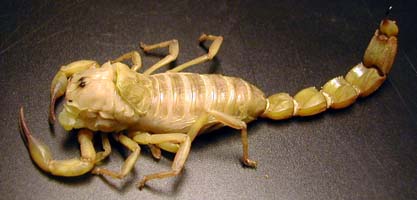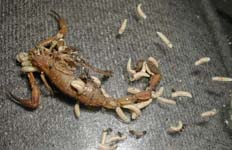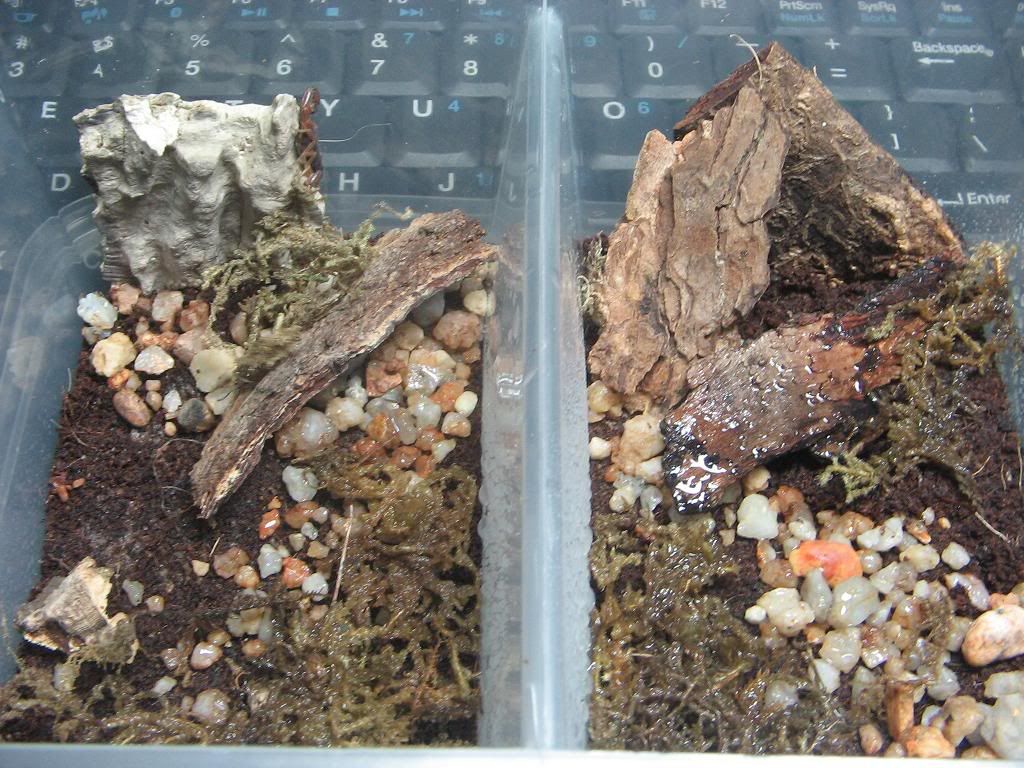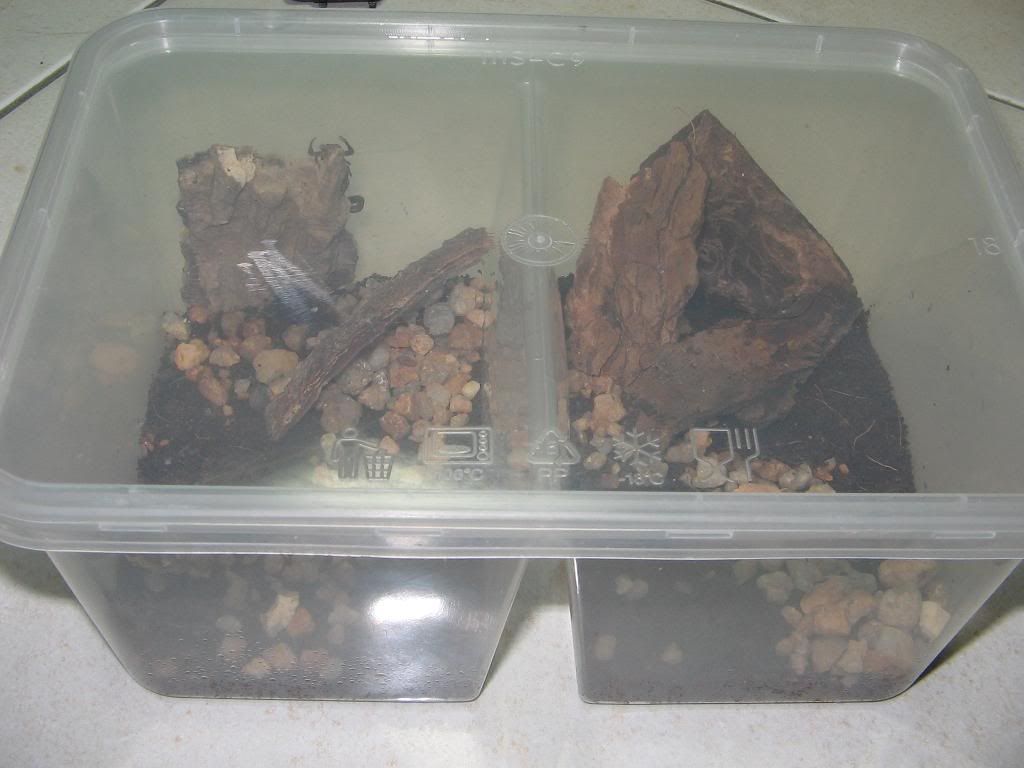Scorpion DiseasesThe mycosis :» Click to show Spoiler - click again to hide... «
The mycoses are fungal infections which benefit from a rate a little high signal of moisture to develop on the primarily desert scorpions. One often finds these mycoses on Hadrurus, Androctonus in the form of brownish or blackish spots, more or less small. They nothing but do increase with the wire of time, and are propagated quickly until the scorpion dies. These spots are easily visible on the yellow scorpions, but much less quickly detectable on scorpions to which the color is close to the black. In fact often the parts in contact with the ground are touched in first, namely, the combs, the sternites, the legs, the rings of the metasoma (tail), and less often the pedipalps, the prosoma, the tergites.

These mycoses can be treated with market products in pharmacy and used for man, but in proportionings much weaker. One can also get, always in pharmacy, of the parahydroxybenzoate of methyl, diluted in alcohol, which one locally applies with a cotton stem. The simplest remedy is to give a good ventilation to the terrariums and to decrease vaporizations.
» Click to show Spoiler - click again to hide... «
These attacks appear as spots, more or less regular, and of different colors from the white to the black. These spots become holes which bore the carapace of the scorpions and proliferates then in the organism of this one. Death occurs always afterwards of long month of waiting. They touch especially the scorpions living in wet medium, the specimens most often reached are Pandinus. They are the result of a proliferation of bacterium generally due to a bad hygiene of the terrarium. We indeed noted that the breeders giving of the mice (alive or defrosted) to their scorpions were reached of this case, and that the others never noted this problem. The mice are very seldom finished, also the time which the scorpion takes to eat this mouse benefits the bacteria to multiply above. Moreover scorpions generally take along the prey in the burrow and does not finish it, which increases the proliferation of the bacteria further.
For the moment, we do not have, alas, any remedy to give. Most of the time when the attacks are discovered it is already much too late. Best is to avoid giving small mammals to the specimens living in wet medium, if not it is necessary to withdraw as quickly as possible the remainders of meal before it did not rot.
Moult Problems :» Click to show Spoiler - click again to hide... «
Problems of moults, which are at the very least very frequent, can also cause fatal consequences. It happens that for various reasons, the scorpion entirely did not leave the molt. The old skin, thus remains stuck on the news. That also arrives at the level of the pedipalps, of the legs, but also of the metasoma. The case which interests us is as follows. The old skin remains stuck on the anus of the scorpions, the anus is between the telson and the fifth segment of the metasoma. Your scorpion will live a little time, it will eat as usual, but it will never be able to defecate. It will inflate until what its intestines perforate and which its excrements fill up its abdomen. Of course it will not remain to him any more very a long time has to live.
A leg, a pedipalp imprisoned in the old skin will have for being cut most of the time. The embarrassment caused by this dead appendix could prevent the scorpion from being correctly nourished. It is as possible as the dead part rotted and causes diseases being able to be fatal. The cutting will have to be very made with a tool (scissors) edge. It will also have to be taken care that the loss of hemolymph (blood) is not too significant. You do not worry for your scorpion, a leg, a pedipalp in less will not prevent it from living. Moreover if your scorpion is not yet adult, it will be able to regenerate partly or completely the lost article.

Above, an Androctonus australis died during the moult, without apparent reason. Blockings on this level are, for the scorpions, always fatal. It is impossible to help the specimen to leave the exuvie without being likely to tear off to him certain parts like the pedipalps, the legs or the metasoma.
» Click to show Spoiler - click again to hide... «
The scorpions are naturally parasitized in their land of origin by various nematodes, they are the small ones towards which, most of the time, does not pose a problem. Only, the various stresses generated by the capture, the travel and the captivity, weaken the defensive systems of the scorpion and at this time there, the parasites take the top and manage to make die their host.
There is alas, no means of knowing if your scorpion is parasitized or not, according to some researchers 2/3 of the scorpions taken in nature would be carrying these parasites. It is not possible to manage an unspecified purging with the scorpion in order to eliminate these nematodes.
Acarina :» Click to show Spoiler - click again to hide... «
The acarina are the parasites most usually meet on the scorpions. Whether it is in natural environments or breeding. For most of the time it is not necessary to worry, however acarina are much more aggressive than others and come to place themselves on the level of the chelicera and on the articulations of the various appendices of the scorpion. Now we suppose that these parasites prick the skin in order to be nourished. It is possible besides that the acarina, by their puncture, weaken the scorpion and that they can to also bring diseases them. These acarina seem indifferent to the nature of the substrate used, but proliferous in tropical terrariums (wet and hot).
It is very difficult to get rid of these acarina. The changes of substrate and the cleaning of terrariums do nothing but slow down the development of the eradic population but it step. We tested several solutions with more or less success. The first consists in whitewashing the places where places the acarina on the scorpions, with household soap. It is then necessary to insulate the scorpion in a pot with slightly wet paper absorbing during a few times. Another solution was to get other acarina to us... But those are the predatory ones, and attack the other acarina. According to various tests in various stockbreeders, the tests one were rather very conclusive, but that did not prevent the acarina from returning by the means of the crickets raised out of battery and sold in the trade to nourish the animals.

» Click to show Spoiler - click again to hide... «
Phorid flies are small flies of the size of a drosophila. It is not too this fly which worry us but his larva. Indeed, this larva is carnivorous, contrary to the larvae of the drosophilas which them are frugivorous. The phorides are generally involuntarily imported with limp of crickets bought in the trade. These flies will cause damage at the time of the moults of scorpion. The flies comes to lay an egg on the new skin and far from solid from the scorpion, the larva will leave this egg in very little time and will begin carnage. This larva will perforate the skin of the scorpion and will devour it interior, and like the fly laid several tens of eggs, the larvae spend only a few hours to empty a scorpion of average size.
On the first pictures you have the difference between a phorid flies and a drosophila, on the second here the result at the time of the moult of one Centruroides margaritatus.


Copy paste from:
http://bultel.p.free.fr/En/Acceuil.htm 

 Sep 22 2009, 11:34 PM
Sep 22 2009, 11:34 PM
 Quote
Quote










 0.0171sec
0.0171sec
 0.60
0.60
 6 queries
6 queries
 GZIP Disabled
GZIP Disabled